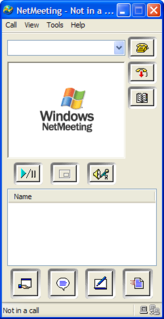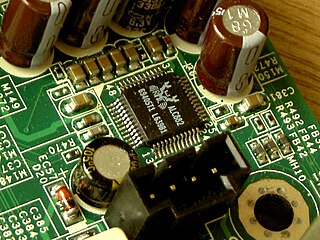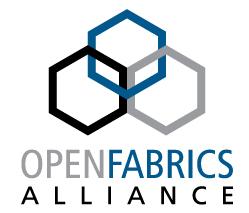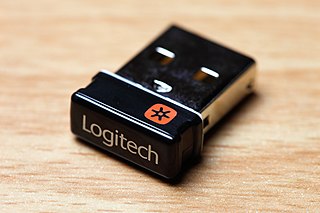Bluetooth is a short-range wireless technology standard that is used for exchanging data between fixed and mobile devices over short distances and building personal area networks (PANs). It employs UHF radio waves in the ISM bands, from 2.402 GHz to 2.48 GHz. It is mainly used as an alternative to wire connections, to exchange files between nearby portable devices and connect cell phones and music players with wireless headphones. In the most widely used mode, transmission power is limited to 2.5 milliwatts, giving it a very short range of up to 10 metres (33 ft).

A software protection dongle is an electronic copy protection and content protection device. When connected to a computer or other electronics, they unlock software functionality or decode content. The hardware key is programmed with a product key or other cryptographic protection mechanism and functions via an electrical connector to an external bus of the computer or appliance.

Broadcom Corporation is an American fabless semiconductor company that makes products for the wireless and broadband communication industry. It was acquired by Avago Technologies in 2016 and currently operates as a wholly owned subsidiary of the merged entity Broadcom Inc.

Microsoft NetMeeting is a discontinued VoIP and multi-point videoconferencing client included in many versions of Microsoft Windows. It uses the H.323 protocol for videoconferencing, and is interoperable with OpenH323-based clients such as Ekiga, OpenH323, and Internet Locator Service (ILS) as reflector. It also uses a slightly modified version of the T.120 Protocol for whiteboarding, application sharing, and file transfers.

Intel High Definition Audio (IHDA) is a specification for the audio sub-system of personal computers. It was released by Intel in 2004 as the successor to their AC'97 PC audio standard.
Avid Media Composer is a film and video editing software application or non-linear editing system (NLE) developed by Avid Technology. Initially released in 1989 on Macintosh II as an offline editing system, the application has since evolved to allow for both offline and online editing, including uncompressed standard definition (SD), high definition (HD), 2K and 4K editing and finishing. Since the 1990s, Media Composer has been the dominant non-linear editing system in the film and television industry, first on Macintosh and later on Windows. Avid NewsCutter, aimed at newsrooms, Avid Symphony, aimed at finishing, were all Avid products that were derived from Media Composer and share similar interfacing, as were Avid Xpress Pro and its predecessor Avid Xpress DV, which were aimed at the lower end of the market.
The following tables compare general and technical information for a variety of audio coding formats. For listening tests comparing the perceived audio quality of audio formats and codecs, see the article Codec listening test.

Nokia PC Suite is a discontinued software package used to establish an interface between Nokia mobile devices and computers that run the Microsoft Windows operating system. Its first release was in 1997, originally called Nokia Data Suite. It was replaced by Nokia Suite and integrated into the Ovi service suite.

Microsoft Corp. v. Commission is a case brought by the European Commission of the European Union (EU) against Microsoft for abuse of its dominant position in the market. It started as a complaint from Sun Microsystems over Microsoft's licensing practices in 1993, and eventually resulted in the EU ordering Microsoft to divulge certain information about its server products and release a version of Microsoft Windows without Windows Media Player. The European Commission especially focused on the interoperability issue.
A Bluetooth stack is software that is an implementation of the Bluetooth protocol stack.

The OpenFabrics Alliance is a non-profit organization that promotes remote direct memory access (RDMA) switched fabric technologies for server and storage connectivity. These high-speed data-transport technologies are used in high-performance computing facilities, in research and various industries.
Proprietary software, also known as non-free software or closed-source software, is computer software for which the software's publisher or another person reserves some licensing rights to use, modify, share modifications, or share the software, restricting user freedom with the software they lease. It is the opposite of open-source or free software. Non-free software sometimes includes patent rights.
SBC, or low-complexity subband codec, is an audio subband codec specified by the Bluetooth Special Interest Group (SIG) for the Advanced Audio Distribution Profile (A2DP). SBC is a digital audio encoder and decoder used to transfer data to Bluetooth audio output devices like headphones or loudspeakers. It can also be used on the Internet. It was designed with Bluetooth bandwidth limitations and processing power in mind to obtain a reasonably good audio quality at medium bit rates with low computational complexity. As of A2DP version 1.3, the Low Complexity Subband Coding remains the default codec and its implementation is mandatory for devices supporting that profile, but vendors are free to add their own codecs to match their needs.

aptX is a family of proprietary audio codec compression algorithms owned by Qualcomm, with a heavy emphasis on wireless audio applications.
Sideloading describes the process of transferring files between two local devices, in particular between a personal computer and a mobile device such as a mobile phone, smartphone, PDA, tablet, portable media player or e-reader.

The Logitech Unifying receiver is a small dedicated USB wireless receiver, based on the nRF24L-family of RF devices, that allows up to six compatible Logitech human interface devices to be linked to the same computer using 2.4 GHz band radio communication. Receivers that are bundled with a Logitech product are paired with the device at the factory. When purchasing a replacement receiver or connecting multiple devices to one receiver, pairing requires the free-of-charge Logitech Unifying software, available for Microsoft Windows and Mac OS X. On Linux the Solaar software can be used to adjust the configurations. Although not compatible with Bluetooth, devices pair to Unifying Receivers in a similar way. Peripherals remain paired, and can then be used on systems not supporting the software. Logitech receivers compatible with the Unifying protocol can be identified by the orange Unifying logo, which distinguishes them from Logitech Nano receivers of similar appearance, which pair in a similar manner but only with a single device, without using the Unifying protocol.

The Xbox Wireless Controller is the primary game controller for the Xbox One and Xbox Series X/S home video game consoles, also commercialized for its use in Windows-based PCs, and compatible with other operating systems such as macOS, Linux, iOS and Android. The controller maintains the overall layout found in the Xbox 360 controller, but with various tweaks to its design, such as a revised shape, redesigned analog sticks, shoulder buttons, and triggers, along with new rumble motors within the triggers to allow for directional haptic feedback.
Crystal HD is the Broadcom's hardware SIP core that performs video decoding.

The Magic Keyboard is a family of wireless computer keyboards produced by Apple Inc. The keyboards are bundled with the iMac and Mac Pro and sold as standalone products, replacing the Apple Wireless Keyboard product line. Each Magic Keyboard model combination has a compact or full-size key layout for a specific region, a function key or Touch ID sensor next to F12, and color scheme variant.










